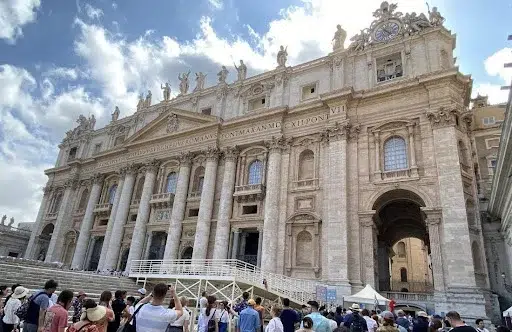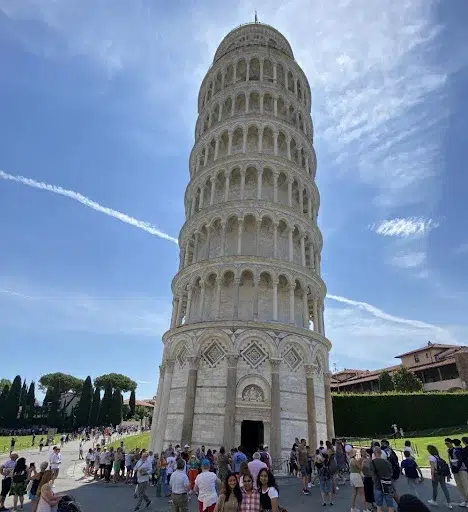We went on a family trip to Italy to enjoy our holidays and catch a glimpse of a few historic sites. Italy is home to the largest number of world heritage sites. We visited many attractions by local trains, rental cars, taxis, and of course, with some walking. I must say we thoroughly enjoyed our time in Italy. I wanted to share our experience, some pictures, videos, and fun facts about a few important attractions we saw. I am neither a historian nor a travel blogger, but I love traveling. As a disclaimer, I would like to state that I do not own the factual statements and some of the phrases presented below, but they were gathered by me from multiple travel sites and travel blogs during our planning. I hope you love reading it and find the information useful. Ever since I read about Romans in school history lessons, I was intrigued by ancient Rome’s rich heritage of architecture, art, culture, and cuisine. The Ancient Roman Empire was among the most powerful empires economically, culturally, and militarily. It is said that ancient Rome was built inch by inch over multiple centuries. Italy is a haven for many architectural and artistic treasures. Italian cuisine does not need an introduction. Every region in Italy, apart from the popular pizza and pasta, offers its own specialty foods. People say there are around three hundred and fifty plus (350) varieties of pasta alone! No matter where you go, you will always find gelato, the Italian name for ice cream. Italy is the fifth-most visited country in the world, and it is little wonder it features on the bucket list of many people.
The Roman Colosseum
One of the new Seven Wonders of the World and the world’s largest amphitheater, the Colosseum, was built in the year 80 CE and is almost 2000 years old. It was constructed during the Flavian dynasty by Emperor Vespasian, primarily for entertainment purposes. In the past, the arena hosted gladiator games, epic hunts pitting humans against wild animals, and even public executions of convicts, criminals, and prisoners of war. Although the colossal ancient structure has been damaged by several earthquakes, it is still maintained in good condition for visitors. The Colosseum attracts approximately 4 million tourists every year.
For over 350 years, the arena was used for human blood-sports and spectacles. During this time it is believed that approximately 400,000 people perished in the arena itself. Among those who perished were gladiators, slaves, criminals, prisoners of wars, and innumerable other entertainers.
The Roman Forum
This sprawling ancient ruin is located adjacent to the Colosseum. Built in the 7th century BCE, the Roman Forum served as the center of ancient Rome’s political, religious, and commercial life for more than a millennium.
The Roman Forum (plaza) is rectangular in shape and is surrounded by the ruins of several ancient government buildings. Ancient Romans referred the Forum as a marketplace.
The forum also served as a memorial site for statues and monuments of Roman leaders and kings. Julius Caesar was cremated on this site, and a temple was subsequently built in his honor. However, a major earthquake struck and damaged most of the Roman Forum in the year 847 CE.

Temple of Antoninus Pius, an emperor of peace and piety that is something of an anomaly in Roman history!

Originally, the Pantheon was a Roman temple and became the burial site for several famous artists and kings. Today it is a church but without a parish.
The Pantheon
Located in the Piazza della Rotonda, the city centre of Rome, the Pantheon is one of the best-preserved ancient monuments in the city. Originally built in 27 BCE, it suffered destruction by fire in 80 CE, and underwent restoration, only to be destroyed once more by another fire in 110 CE. The current structure was completely rebuilt in 125 CE.
The Pantheon is remarkable for its size, construction, and design. Its dome is the largest built unsupported concrete dome in the world and it measures about 142 feet in diameter and 71 feet in height above its base. The exact method of construction of the dome has never been determined.
Trevi Fountain
Built in 1762 CE using the same material as the Colosseum, the Trevi Fountain stands as an immensely popular attraction in Rome. A prevalent myth surrounding the fountain suggests that tossing one coin into it ensures a return to Rome, while tossing two coins signifies a return and falling in love. Furthermore, tossing three coins supposedly guarantees a return, falling in love, and marriage! It’s no wonder that the Trevi Fountain is one of the most famous fountains globally and, predictably, the most photographed attraction in Rome.
Hopeful visitors throw coins into Trevi Fountain. It is estimated that every day three thousand euros worth of coins are thrown into the fountain which translates to a staggering one million euros per year. Every day the fountains is cleaned, coins are picked up and donated to a Catholic charity.

The Trevi Fountain is a free attraction to visit in Rome; no paid tickets are needed. Experts estimate that an average of 1,200 people visit the fountain every hour, which translates to approximately 10.5 million visitors per year to the fountain!
St. Peter’s Basilica
A must-see attraction in the Vatican City, and you will need a full day to visit the Cathedral, museums, and the Sistine Chapel. Perhaps the smallest country in the world, Vatican City is home to the largest Catholic church in the world. St. Peter’s Basilica is an architectural and artistic beauty. It took approximately 120 years to build the present-day Cathedral. Construction began in the year 1506 CE and was completed in the year 1626 CE.

Inspired by the Pantheon, St. Peter’s Basilica was designed to have the tallest dome in the world!

The basilica is named St. Peter’s after one of Christ’s twelve disciples, who was also one of the founders of the Catholic Church. St. Peter was executed in Rome and buried where the Basilica stands today.

One of the most beautiful works inside St. Peter’s Cathedral is Michelangelo’s famous La Pietà, considered by many experts to be the most moving piece of sculpture ever created.
Inside St. Peter’s Basilica, a multitude of intricate structures and artworks enhance the overall grandeur. In addition to the main highlights such as the Dome and St. Peter’s Tomb, the basilica contains numerous chapels, altars, monuments, and tombs.
The Leaning Tower of Pisa
One of the seven wonders of the world, the Leaning Bell Tower is located in the city of Pisa. The city owes its most-frequently visited status to this architectural marvel. Pisa is about a 1-hour train ride from Florence. All major attractions, including the leaning bell tower, cathedral, baptistry, and museums, are situated in the Square of Miracles (Piazza dei Miracoli) complex.

Pisa Cathedral is a medieval Roman Catholic cathedral dedicated to the Assumption of the Virgin Mary.

The round-shaped Baptistry of Pisa is almost as tall as the Leaning Tower. In fact, it is the largest baptistry in Italy, standing at 180 feet tall with a circumference almost twice its height.

Completed in the year 1399 CE, the 185-foot-tall white-marble cylinder is the bell tower of Romanesque architecture. Interestingly, it is not the ONLY leaning tower in Pisa!
Helpful Travel Tips
Italy is an extremely popular and busy tourist destination. Making a complete travel plan 5-6 months ahead of your trip will make your visit easier and more enjoyable. Carefully choose the cities to visit, attractions to see, time to spend at each attraction, accommodations, and the mode of local travel. Meticulously creating a daily plan and booking in advance will not only secure your visit to the attractions but also ensure you get the best prices possible. In my opinion, the best time to travel to Italy is during late spring or early fall. Summer is usually the peak tourist season and can get hotter and busier.
Save Time with Skip-the-Line Tickets
Generally speaking, most attractions in Italy are crowded with long lines and extended wait times. Almost all attractions offer skip-the-line tickets that will allow you admission within a specific time window without having to wait in the general lines. Skip-the-line tickets cost a little more but will save you precious time because you can go straight to the attraction during the specified time window.
Safety of Travel Documents and Personal Belongings
As much as Rome is renowned for its beautiful sites, it is notorious for pickpockets. Losing important travel documents and money will leave you and your family in an undesirable situation. So, keeping both hard copies and digital copies of passports and other travel documents with two or more members of your group will be handy should your originals be stolen or lost. Make sure you have telephone numbers of local embassies, police, and hospitals handy.
Travelling Inside Italy
Most Italian cities are well-connected with high-speed trains. Travelling by train between major cities is probably the best option in terms of cost and time efficiency as opposed to driving rental cars. Within cities, taxis are quite popular and cheaper too. Rome has subway trains, and also most attractions are walkable. Most train stations and major city centres have Stasher for conveniently storing your luggage when you are between accommodations.
Foreign Currency
Getting sufficient foreign currency at your local bank before travelling will not only save time but also get you better conversion rates. Unlike your local banks, the currency exchange centres at tourist spots in Italy charge exorbitant fees for currency exchange.
Pack Medicines
For a stress-free trip, especially to any unfamiliar place, make sure to pack a sufficient supply of daily medications and a first-aid kit with bandages and antibiotic ointment.




